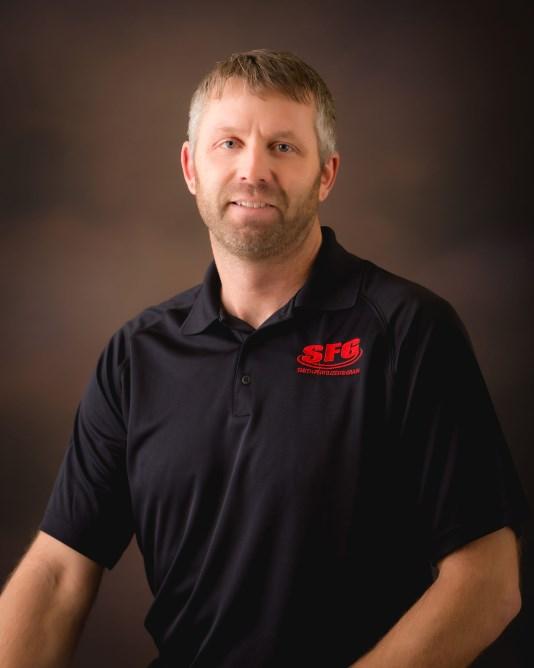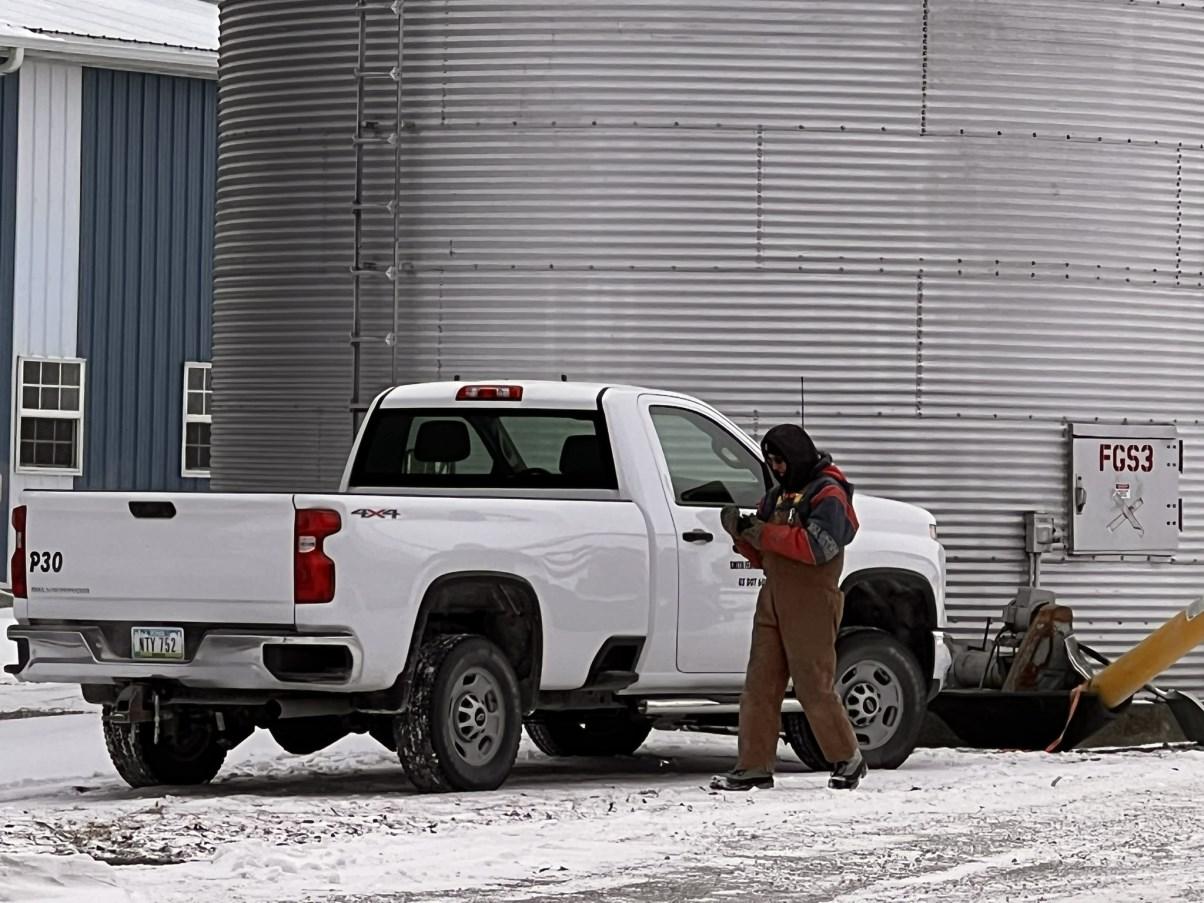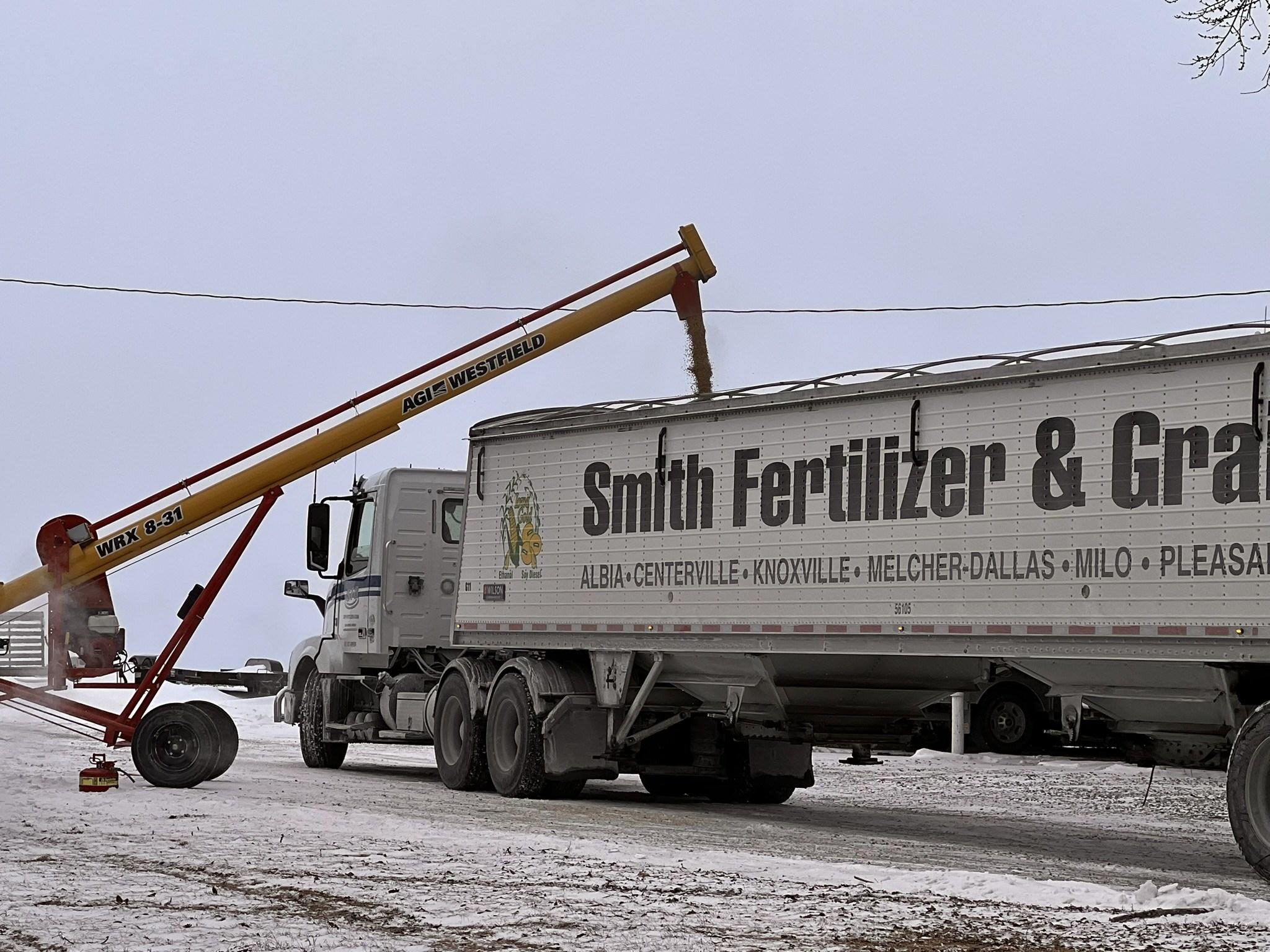


















Derrick Hoodjer



Coming out of the arctic blast we had in February has gotten us thinking about warmer weather. We are a few weeks away from widespread field work, but it’s not too early to think about putting seed in the ground. Now’s the time to do your frost seeding and plant those crops that can handle colder weather. Smith Fertilizer and Grain has a full line up of seeds for any crop you plant in 2025.
Planting in March generally consists of frost-seeding clover species. This is a good way to fill in some pastures and fields that may have thinned during the winter, or to add some protein to a grass pasture. Red clover and white clover are the most common frost-seeded clovers we use in South Central Iowa.
We generally don’t recommend frost-seeding grass, as it is at higher risk with cold temperatures. It’s safer to wait until later to get those areas planted. Waterways, terraces, and new pastures are good to get seeded at that time. You want to catch those April rains on a new grass seeding, much like your lawn.
Weather predictions for Spring have been on both ends of the spectrum. According to the fog days, we are going to start getting rain in late March or early April. But the climatologists predict an overall drought for the growing season. Whatever mother nature throws at us, we should still plan to put corn and soybeans in the ground as soon as we’re able. The years we get planted in the middle of April instead of the middle of May tend to have higher yields. On corn we want to make sure conditions are almost perfect. It seems we only have one chance at the highest yield opportunity. In my opinion, dry conditions are more critical than soil temperatures. I don’t want to see any 40-degree soil

temperatures when planting, but as long as it’s dry I have seen some very good results. As long as we are avoiding wet planting conditions, we seem to have had no large issues with planting corn early.
Planting soybeans as early as possible has been a topic of discussion in the last few years. Some producers are even planting soybeans before corn, as soybeans are more forgiving to cooler soil conditions. If you have a full fungicide and insecticide treatment, this may work out. If you must choose between one or the other, I’m still leaning on planting corn first. Soybeans may be more forgiving planting in cool soil, but they are a lot less forgiving if we get a late frost. Soybeans the are 3-4 inches tall that get hard frost on are much more susceptible to dying off than corn.
If you have any questions regarding Spring seed items, don’t hesitate to reach out to your Smith Fertilizer & Grain Agronomist. We are here to help make the 2025 growing season successful!














The nice weather this week has the feel of spring in the air, and many customers have decided to work on finalizing their agronomy plans for the 2025 season. I am hoping the old saying “March, in like a lamb out like a lion” does not come true this winter.
SFG’s agronomy salespeople are Certified Crop Advisors. With that certification, we are required to have regular training to keep us up-to-date and knowledgeable. The training sessions I attended this winter have included two topics which are high on my priority list: Multi-mode of action chemical programs and applying sulfur with our fertilizer.
There are no new chemicals on the horizon, and every chemical that we have available has some sort of tolerance or resistance somewhere in the world. To maintain effectiveness of the chemicals that we have for as long as possible, we need to spray multiple modes of action with a good residual. Once a weed learns to tolerate a chemical, it’s all downhill from there.
Sulfur/nitrogen ratios are critical to keeping plants healthy, as nitrogen is better utilized in the plant with the addition of sulfur. Adequate sulfur in the soil may also make nitrates more stable.
Talk to your local SFG agronomist about finalizing your agronomy plan for 2025 and making sure that you are using a good two pass chemical program and adding sulfur to your acres.









Greg Willer



It is starting to feel like Spring with the warm weather we are having, and growers are starting to make their final input plans for this coming growing season. Once it dries up, we will be back in the field applying dry fertilizer and getting ready to plant the crop.
Besides weather, nitrogen availability is often one of the biggest growth factors. Smith Fertilizer & Grain can broadcast urea over the top and knife in 32%. There are advantages to both practices. Broadcasting over the top will run over less corn because of a larger pattern, while knifing in the product means you don’t need rainfall to work the product into the ground.
The markets seem to favor corn for now, and many are wondering how they can gain the best yield they can. One proven way to get a few more bushels is by split-applying your nitrogen. We are also able to add sulfur to help with any sulfur needs. We have seen over the last few years that sulfur deficiency is showing up more and more in corn.
Nitrogen is one of the biggest factors in how much yield you will have. When finalizing your nitrogen needs this spring, make sure to ask about side dressing your corn with your SFG agronomist.














After a week in the freezer, temperatures have warmed up and it’s feeling more like spring. At the moment, pretty much all the snow is melted off and hopefully, barring any rain, we may start to dry up in the next week or two and be ready to get in the fields.
There has already been some talk in the countryside about getting nitrogen on wheat fields as well as pasture. Some seed is starting to move for inter-seeding pasture and hay. Soon we will be back to spreading fertilizer and putting NH3 on. Anyone who still has work to get on the list for spring, contact your local SFG agronomist to get those plans taken care of.
Here in Centerville Jason has had the outside crew busy getting tanks, toolbars, fertilizer carts, and tending equipment ready for spring. We are ready to take care of your acres when the fields are ready.
This is also a good time to get soil samples done if you weren’t able to in the fall. If you get them done quickly, there should still be time this spring to get results back in time for this year’s fertility plans.
Soon we will be headed to the fields and everyone will be busy. As always, stay safe out there and don’t hesitate to contact your local SFG agronomist with any questions!










Mark White Grain Division Manager



Tune in weekdays at noon to 96.7 KIIC for the latest market news, sponsored by Smith Fertilizer & Grain!




As you prepare to plant your 2025 crops it will be important to put some type of grain marketing plan together. For some that will include marketing the remaining 2024 crop you still have. The coming year is shaping up to be a difficult year to find profit in our row crops. We experienced almost 3 years of good markets, but that course changed over a year ago. When times are tough like this the easiest marketing plan is to sit on your hands until you need some cash. However, this can put you in a vulnerable position. The first thing you need is an idea of what your breakeven is, so you know when the market gives you an opportunity. From there marketing plans can be either simple, or as intricate as you want. Very few of us, probably no one, can pick the best single time to sell. A better method is to sell your crop in increments. You can pick a date for every month to sell a percentage of your crop, or you pick a realistic price to start your marketing and then sell more if the market goes up say a quarter. The hard part here is being able to recognize when you should sell if the market moves lower. You also need to factor in storage and interest costs if you plan to hold the crop for a length of time. It takes carry in the market to make this work along with the thought prices will work higher. Going into this spring we are dealing with healthy supplies of corn and beans, not only here but worldwide. Add in possible tariffs and continued unrest in the Middle East and Ukraine and the crystal ball gets cloudy in a hurry. Even more reason to get this marketing plan put together. Give us a call at SFG if you want some further marketing information.












Spring is here in Iowa. With field work, planting, and calving season, that means a busy time of year for farmers. Handling all that and trying to keep young calves healthy can get stressful. Calves can be sick from many different things this time of year. Cattle producers have several challenges that they face at this time of year, but we have tools that can make life a little easier.
It all starts with colostrum. Colostrum is full of protective immunoglobulins that must be absorbed within the first 24 hours of birth. This allows the calf to develop passive immunity against common illnesses. To ensure that the colostrum is absorbed on time it must be consumed as soon as possible, preferably within the first 2 hours of birth. The calf should have 5% of their body weight consumed within 4 hours. This means that for an 80pound calf, 4 pounds or 2 quarts would be needed.
If a cow doesn’t let down much colostrum or the calf is struggling to suck, this can lead to illness and problems for the rest of the calf’s life. Products like OptiPrime colostrum can be a helpful tool to keep on hand in case a calf needs just a little more. With 150 grams of globulin protein this product can be used as a full replacement if needed or diluted to make a supplement as well.
Another problem that we fight this time of year is scours. We have all heard the neighbors down the road talk about their way that worked 30 years ago to prevent scours. But for a simple and guaranteed fix for this age-old problem, today we look to BioMos. This tool can be fed directly in a ration, mineral, or a calving tub. It works in the gut to bind up pathogenic bacteria like E. coli and prevents them from attaching to the intestinal lining, which causes scours. By feeding Bio-Mos starting three weeks before calving we can cut back on scours and help calf health greatly.









Calving season is here, and we need to make sure we’re taking care of mama and her babies. While it seems a ways off, we need to remember fly control.
You want to start feeding a quality fly control product two to three weeks before fly season. This allows your herd to build up some immunity to flies before the weather warms and insects hatch. As a general rule of thumb, flies start appearing around April 15th, so you want to start mineral in mid to late march.
Clarifly, Altocid/IGR, and garlic are all products we have access to. Clarifly controls all flies, Altocid/IGR controls blood-sucking and horn flies, while garlic is an all-natural organic solution for those needing that option. We stock mineral and/or tubs with these products worked in, or you can buy these products on your own for top dressing or mixing in with your grind and mix rations.
And, it is early for this, but keep it in your mind for this summer: Fescue and breeder mineral. Be sure to watch SFG’s Facebook page for updates on any specials we might run. With cattle prices as high as they are, you want to make sure your heifers get bred back as quick as possible.
Give us a call any time and let help you help your herd!
Spring is a busy time of year, but with the proper tools and nutrition, calving season can be one less thing to worry about. Stop by or call any of our locations and ask about how Bio-Mos and colostrum can make your calving season a success.

















The weather is warming up and spring is here. It’s amazing how much water some of the tile lines are running. One of the things I like to do before the crops are planted is to get out in the fields and find those tile outlets to make sure they’re working like they should be. It’s easy to forget about them sometimes, and the next thing you know they’re grown up in tree roots or covered up with weeds. I also like to get my eyes on the terrace intakes. We all know wildlife tends to knock them over, which then opens lines to debris that will cause them to plug up and not work.
As we go into spring planting season, it always seems like as much as we try to get our fields fixed up, we always find one we’ve missed or spots that need attention. Sometimes it’s better late than never to get those spots the attention they need. Those spots hurt your yield more than you think.
Keep SFG Construction in mind for any projects that you have on your farm. If you can’t get to them this spring, you can always take advantage of summer weather. Those spots on field edges are a perfect summer project. We can also help you with old fence rows, pond building, or pasture work as well. Give us a call at 641-891-5593 and we will do our best to help you out!










The Road Maintenance department is gearing up for dust control. For those of you that live in Marion, Monroe, Lucas, Warren, and Appanoose counties here in Iowa, check out our website at www.sfgroadmaintenance.com for information about this year’s dust control. We will be taking applications beginning in the middle of March and continue to take them until the 2nd application deadline passes for each county. Applications are or will be available for download on our website. These applications will have pricing as well as deadlines that need to be met to receive your spring and summer dust control.
Please remember to have your flags properly placed at the footage you would like sprayed. We have an electronic monitor which is calibrated at the beginning of each year to guarantee that we are spraying the correct footage asked for. If we spray your footage asked for and it is not the distance of the flags we will stop when we hit that ordered footage. This eliminates the issue of having to go back and contact our customers for the correct payment for the footage designated by the flags.
Also, please make sure that your flags are clearly visible. For those of you that leave your flags out year-to-year, many things could have happened during the fall, winter, and/or spring that could have caused your flags to disappear or become damaged. There are replacement flags available at your county shops or at any SFG location, depending on what county you apply for dust control in. These are free of charge if you have submitted the proper paperwork for your dust control. If you have any questions at any time, please give us a call at 641-828-8508 so we can provide you with the service you expect.

















Jason Jensen, Northwest Agronomy District
JasonJ@SFGIowa.com
641-891-9323
Clark, Lucas, Western Marion, Western Polk, and Warren Counties

Greg Willer, Northeast Agronomy District
GregW@SFGIowa.com
641-891-7457
Jasper, Mahaska, Eastern Marion, Northern Monroe, Eastern Polk, and Poweshiek Counties

Mike King Northwest Feed District MikeK@SFGIowa.com
Western Lucas, Marion, Northern Mahaska, Western Wayne, and all points North and West
White,
Jason Jensen, Manager
Drey Smith, Office Manager
101 1st St Milo, IA 50166

Taylor Banks, Southern Agronomy District
TaylorB@SFGIowa.com
641-218-0286
Appanoose, Davis, Decatur, Southern Monroe, Wapello, Wayne, and all Missouri Counties

CD Brinegar Southeast Feed District ChaseB@SFGIowa.com
Monroe, Keokuk, Eastern Lucas, Southern Mahaska, Eastern Wayne, and all points South and East

Stephen Leeds, Manager Chad Lynch, De-icing Sales
1650 Quebec St Knoxville, IA 50138
Office: 641-942-6223 Office: 641-828-8508